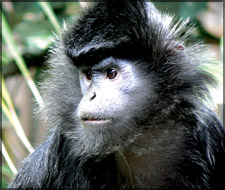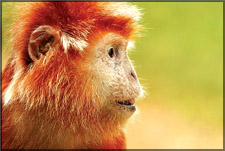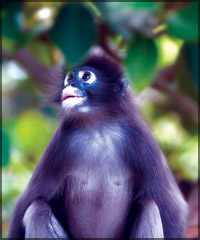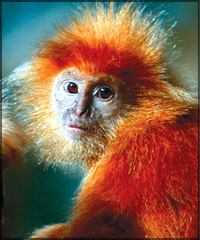Leaf monkeys are mostly vegetarians!
Last week we introduced you to a fascinating member of the Animal
Kingdom, a species of monkey known as the saki. As we mentioned in that
article, there are different kinds of monkeys with varying features,
habits and lifestyles.
Today too, we feature yet another relative of ours from the primate
world, the Leaf monkey, which is an Old World monkey. Now, if you are
wondering why monkeys or for that matter any other animal is called an
Old World or a New World animal, let us briefly enlighten you.
Scientists generally classify animals that are native to Africa and
Asia as those belonging to the Old World.
There are many differences between the Old and New World creatures
and in the case of Old World monkeys or Ceropithecidae too, there are
such differences. For instance, several Old World monkeys have
anatomical (body structure) oddities, like in the Proboscis with its
extraordinary huge nose, and the snub-nosed
|

Francoisí leaf monkey |
|

Silvered leaf monkey with baby |
monkey which seems to have
no nose at all.
Meanwhile, most Old World monkeys are primarily omnivorous, but all
prefer plant matter. The majority have tails (unlike apes).
However, they do not have prehensile (grasping) tails like the New
World monkeys. Old World monkeys inhabit a range of environments from
rainforests to savanna, scrubland to mountainous terrain. Medium to
large sized, these monkeys range from arboreal (living in trees) like
the colobus, to fully terrestrial (living on land) forms such as the
baboons.
The smallest Old World monkey is the Talapoin which is about 0.7 -
1.3 kg in weight and 34-37 cm in length. The largest is the male Mandril
which is about 70 cm in length and weighs around 50 kg maximum.
Now, letís check out what the Leaf monkeys are like ...
Leaf monkeys are considered to be the most vegetarian among monkeys
and it is not surprising, taking into account their name.
These diurnal (day time) and arboreal forest dwellers have large
stomachs - which are multi-chambered like those of ruminants such as
cattle and deer. The forestomach supports bacteria with cellulose
(digesting abilities).
Leaf monkeys are classified under different names such as Banded leaf
monkeys, Grizzled leaf monkeys, Capped leaf monkeys, Maroon leaf monkeys
Silvered leaf
|

Ebony leaf monkey |
|

Javan leaf monkey |
monkeys, Dusky leaf monkeys, Purple-faced leaf monkeys,
going by their physical appearance, regions they live in and traits.
The Silvered leaf monkey is about 5-7 feet in length and weighs about
6.6 kg. It is identified by its silver-tipped fur and dark-skinned face.
However, the newborns have bright orange coats. Hands and feet and face
are white, but turn grey and then black, as they grow.
Like all leaf monkeys, the Silvered leaf monkey too travels about in
groups of 9-15 individuals. Travel is initiated and coordinated by an
adult male because it has an unimale social structure. The group starts
moving before sunrise and stops travelling before it becomes dark. Males
usually live a solitary life until they form new groups.
These groups are highly territorial and act aggressively towards
other individuals. Fighting consist of slapping and pulling with some
biting involved. Females allow other females to carry and care for their
young. Adult males have also been observed to carry and care for
immature group members.
Social play has been observed among this species of monkey, mostly
among juveniles of both gender. But, individuals of all ages also
participate. Wrestling is the most common form of play. Juvenile males
engage in the most vigorous form of play-fighting.
When communicating, the young males and females make a call which
sounds like ho , to address each other from a short distance, while
adult females greeting each other says ku - ku. Infants in a peaceful
state make a noise that sounds like ku and adult males controlling
travel movements of the group say kwah at repeated intervals.
|

Banded leaf monkey |
|

Purple-faced leaf monkey is endemic to Sri Lanka |
These monkeys make different sounds for alarm calls, attack calls,
fear calls and threat calls. They also resort to visual communication
such as yawning, branch shaking, head shaking and chasing.
The Silvered leaf monkey gives birth to a single offspring with
births occurring throughout the year. The Silvered leaf monkey inhabits
Brunei, Burma, Cambodia, Indonesia, Laos, Malaysia, Thailand and
Vietnam. Four sub-species have been identified.
The Dusky leaf monkey also called the spectacled langur is found in
Thailand and the Malay Peninsula (in southern Asia) in forests,
scrublands and plantations. It is a rather common monkey. Being an
arboreal forest dweller, it prefers dense forests with tall trees.
This monkey is widely variable in colour; the upper part of the body
(or outer coat) may be grey brown or black whereas the under parts,
hindlegs and tail are paler. The face is grey and often marked with a
patch of white fur located around the mouth and eyes. Hence the name,
the spectacled langur.
Its hands and feet which have the ability to grasp, closely resemble
those of humans. Palms and soles are usually black and hairless.
The fingers are well developed. Head and body length ranges from 42
to 61 cm and tail from 50 to 85 cm. On average, a healthy adult male
would weigh around 7.4 kg and a female approximately 6.5 kg. Newly born
Dusky monkeys are bright yellow or orange in colour with a pink face.
Within six months the fur changes colour to grey.
Dusky leaf monkeys are diurnal. They are very active by day, but
return to their tree roosts in the nights.
The monkeys travel in groups that consist of 5-20 individuals. Social
groups usually have one or more adult males, and two or more adult
females.
|

Dusky leaf monkey |
|

Maroon leaf monkey |
The adult male has three responsibilities - that is to detect
predators, hold the group together and patrol the boundaries. The young
monkeys always play near an adult female.
This monkey has a wide range of calls that are considered to be quite
complex.
It uses a variety of snorts, hoots, murmurs and squeaks to
communicate with other members of their social group.
When moving from tree to tree by climbing, leaping and running
quadrupedally (on all four limbs) along branches, the motion of the tail
plays a significant role in maintaining balance.
The diet consists of young leaves, shoots and seedlings. They feed
from 87 different species of trees. In general a Dusky leaf monkey eats
up to 2 kg of food per day.
Francoisí leaf monkey, also known as the white side-burned leaf
monkey, Francoisí langur or Tonkin is found in southern China (Guangxi
and Guizhou Province), central Laos (east of Mekong River) and northern
Vietnam.
The family group comprises 3-12 individuals including 4-6 females and
several young.
The monkey spends most of its time on trees and sleeps outside during
mild weather and in caves during cold winters.
The Grizzled leaf monkey which is also known as the Javan Grizzled
Langur, Stripe-crested Langur or the Gray is considered to be
endangered, due mostly to loss of habitat. In fact its natural habitat
has decreased by about 50 per cent in the last decade alone.
The family groups which number 6 to 7 individuals are very
territorial. Endemic to the western half of Java Islands and found
mostly in rainforests, the Grizzled leaf monkey is mostly a folivorous
(leaf eating) animal with 62 per cent of its diet comprising young or
tender leaves and another 6 per cent, mature leaves.
The Banded leaf monkey is suspected to be a subspecies unique to
Singapore. It was discovered in 1925. About 68-80 cm in size, it is
found in forest habitats restricted to the Central Catchment Area. A
small population of this species which is endangered due to habitat loss
is found in this area.
Arboreal and gregarious (living in communities) this monkey travels
in groups of about 20 individuals. Usually these monkeys move in an
extended line. It can leap well from tree to tree.
Meanwhile, Ebony leaf monkeys, also known as lutungs are only found
in Indonesia and are becoming rarer. It has a bulge over the eyes and
lots of fur on the head. It grows to lengths of 40-80 cm and weighs
between 5-15 kg.
Often preferring rainforests, the monkey spends the largest part of
the day in trees, crawling along the branches on all fours. But it can
jump well from tree to tree like most monkeys.
There are more kinds of leaf monkeys, so try to find out about their
interesting lifestyles.
Facts and pix: Internet |
